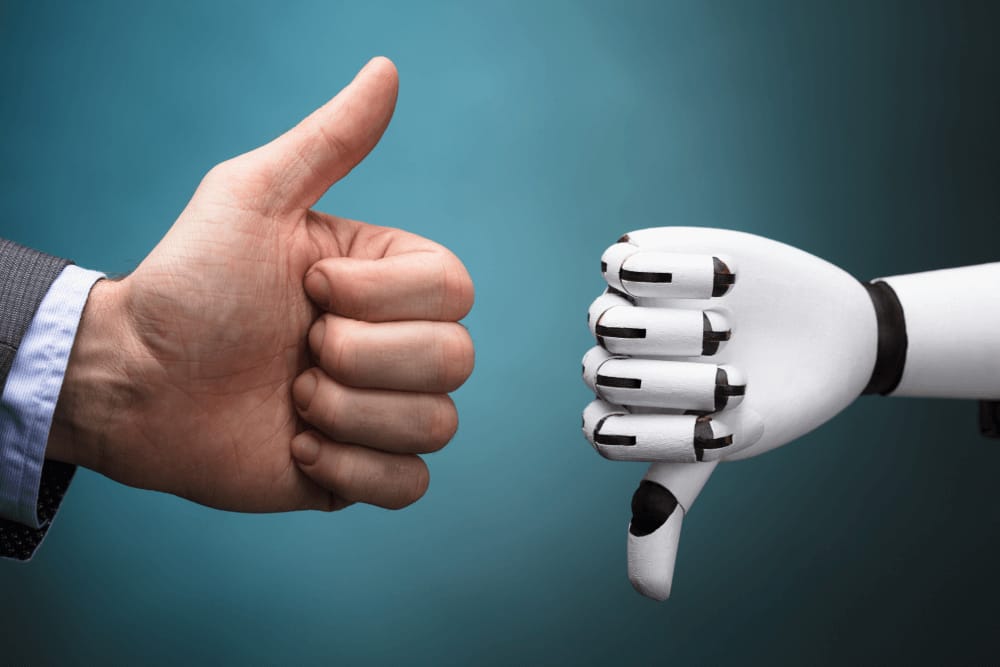Artificial Intelligence (AI) holds enormous potential for public progress, but it also exhibits certain risks that may establish a threat to mankind. AI has both positive and negative impacts on humanity and society. On the positive side, AI can for example increase efficiency and support in healthcare in both clinical and patient use, assist with legal services and demands, and increase access to research and development and education (Lifewire, 2023). One concern is the possibility of AI systems becoming so advanced that they exceed human intelligence, a phenomenon known as “the singularity” (Hunt, 2023). In such a situation, these advanced AI systems may make choices or perform actions that humans cannot recognize or limit, possibly leading to unpredictable and hypothetically harmful consequences (Hunt, 2023).
For example, AI is being used to enhance data analysis and solve complex problems such as improving customer service (Brilliantio, 2023), and it is also assisting in creating ease of access for differently-abled individuals (Lifewire, 2023). Additionally, AI-powered technologies such as digital personal assistants and smart home technologies are making our daily lives simpler and more convenient (Salokenal, 2023). Nonetheless, on the downside, AI can lead to job displacement due to automation (Thomas, 2021), (Duggal, 2023). There are also ethical concerns about bias and privacy, as well as security threats from hacking (Thomas, 2021). The lack of clarity and precision in AI and deep learning models can lead to inappropriate or dangerous decisions (Duggal, 2023). Similarly, the rapid advancement of AI, leading to the capability of AI toppling human intelligence, establishes a significant threat (Hunt, 2023). Therefore, it is crucial to balance the advantages and dangers of AI and to implement healthy ethical standards and controls for its advancement and use (Dougal, 2023). Furthermore, there are fears about the exploitation of AI in areas such as autonomous weapons or surveillance systems, which may violate privacy rights or be used maliciously (Vallance, 2023). Thus, it is important to execute strong ethical standards and controls for the development and use of AI to prevent these risks (Vallance, 2023).
Throughout history, innovation has consistently been a catalyst for enhancing the quality of life. Innovation is not without its challenges, often leading to notable disruptions around the world. Previous examples of notable worldwide disruptions in the last three decades were related to technological advancements, innovations such as the Internet of Things (IoT), big data, data science, cloud computing, and now the adoption of AI. All of these items have existed for at least 25 years, but only recently has AI begun to gain widespread acceptance. AI has the potential to generate strong profits, efficiencies, and be economically feasible for businesses or individuals to implement (Chui et al., 2023). In the following sections, the positive and negative effects of using AI will be discussed.
Positive Effects of AI
One potential positive effect of using AI could be the ability to solve challenges in various domains such as climate science, drug discovery, and engineering. Using AI, simulations can be created by scientists and researchers to investigate many different scenarios and enhance solutions without the need for expensive and time-consuming physical experiments. Learning to use generative AI enables society to enhance creativity by rapidly producing text, art, or music. AI provides the ability to automate routine and time-consuming tasks, leading to significant productivity increases by streamlining repetitive processes.
Grundner and Neufer (2021) researched the existing gaps in the literature by actively contributing to the advancement of AI in tourism destinations. The goal of their study was to comprehensively explore both the positive and negative aspects of AI within the tourism destination experience, promoting a deeper understanding of its implications. Their results indicated that the primary impacts of AI on the future tourist experience are evident in three specific themes: information, personalization, and extensive technological integration.
CITAKETAL. (2021) explores respondents’ perceptions and attitudes towards AI, specifically its integration within the hotel environment. Their goal is to explore how potential customers can encourage the hotel industry to adopt specific AI solutions. Citakal et al. (2021) results suggested that the most significant AI positive impact within hotel services involved self-service check-in and check-out services. This affected how guests were assisted upon their arrival or departure from the hotel.
Negative effects of AI
A potential negative effect of using AI may relate to generative AI, in particular large language models (LLMs), where it has the ability to produce a vast array of content in different contexts. The quality of the content generated by these tools is contingent on the quality of the data they are trained on, and the technology can harbor significant flaws. An example of a flaw using these tools is the ability to present false statements as factual events, this is commonly referred to as ‘AI hallucinations’. Another example of a flaw using these tools is that it can exhibit bias and susceptibility to leading questions, making it easily influenced. These tools can be manipulated to generate harmful content and lead to corruption.
Arnaout and razniewski (2023) investigated the ability of LLMs to produce remarkably negative statements about real-world entities. They assessed the accuracy and relevance of LLMS-generated lists related to topics from various domains. Their evaluation indicated that the guided probes used in their investigation actually enhanced the quality of the generated negatives. They concluded that despite recent advances, LLMSs continue to face challenges regarding the factual accuracy of negative statements. LLMSs often produce many ambiguous or positively interpreted statements despite the presence of negative keywords.
Another example of AI negative impact can be job displacement. A branch of AI called machine learning (ML) uses algorithms to accomplish tasks by understanding statistical patterns in data, as opposed to strictly following human instructions. This technology has recently demonstrated extraordinary proficiency in a diverse range of economically important tasks. ML can replace humans in many diverse economic jobs that are associated with high-paying occupations. Several examples of this diverse job sector are radiologists, media jobs, tech jobs, market research analysts, finance jobs, traders (stock market), graphic designers, accountants, customer service agents, and agricultural workers.
Webb (2019) examined how to predict the effects of any technology on occupations. Webb created a new method for identifying which tasks could be automated by any specific technology. Webb found that AI effects would be highest for high-skilled occupations, suggesting that AI would affect people very differently than software and robots.
Valle-Cruz et al. (2023), proposed a model for examining the negative effects of artificial intelligence (AI) within government contexts. They organized 14 aspects of its harmful effects into five sociotechnical categories. Their research outlines key areas within the topics of artificial intelligence and intelligent algorithms that warrant attention. Their results indicated that the five negative impacts of AI within government contexts are data and technical (bias, errors, fake news), organizational and managerial (workforce and human replacement, dependency), political, legal, and institutional (morality, ethics and law, human rights, privacy, injustice, weaponization, national and information security), environmental (markets, and information security).
Read Also:
- Banking History of Artificial Intelligence (AI) In India
- Opportunities Of Artificial Intelligence (AI) In Indian Banking Sector
- Artificial Intelligence In Healthcare
- Artificial Intelligence In Indian Banking Sector: An Overview
- What Are The Types Of Artificial Intelligence Tools
- Role Of Artificial Intelligence In Indian Agriculture
- Artificial Intelligence (AI) Techniques Used For Diseases Detection In Agriculture
- Artificial Intelligence In Agriculture







